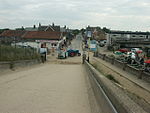Hickling Hall
Grade II listed buildings in NorfolkHickling, NorfolkNorfolk building and structure stubs
Hickling Hall was a grade II listed house in Hickling, Norfolk, England. Dating from the 18th century, it was destroyed by fire on Boxing Day, 26 December 2014.The building was made from brick, with a slate roof, and had two stories across seven bays, with a dormer roof. It was accorded grade II status in 1955. The hall is currently being rebuilt. As of mid-summer 2016, missing brickwork has been replaced and new floors have been fitted.
Excerpt from the Wikipedia article Hickling Hall (License: CC BY-SA 3.0, Authors).Hickling Hall
Sea Palling Road, North Norfolk Hickling
Geographical coordinates (GPS) Address Nearby Places Show on map
Geographical coordinates (GPS)
| Latitude | Longitude |
|---|---|
| N 52.764 ° | E 1.5744 ° |
Address
Sea Palling Road
Sea Palling Road
NR12 0AZ North Norfolk, Hickling
England, United Kingdom
Open on Google Maps










